Papers by Edzard van Santen

Journal of Economic Entomology, 2021
Commercial beekeepers need healthy, productive honey bee (Apis mellifera L.) colonies, even when ... more Commercial beekeepers need healthy, productive honey bee (Apis mellifera L.) colonies, even when the landscape lacks adequate pollen forage to sustain the colonies. As a result, many commercial beekeepers spend significant money and labor on the use of pollen substitutes in their colonies. However, there is little consensus in the literature about the benefits and drawbacks of pollen substitute use on honey bee colony health. In order to understand this critically, it is important to know first how honey bees distribute pollen substitute patties throughout their colonies. We traced the fate of three commercially available pollen substitute patties (MegaBee, UltraBee, AP23) dyed with a nontoxic food coloring (Brilliant Blue FCF) and undyed as negative controls, a dyed positive control (fondant), and a dyed consumption control (Crayola Model Magic Clay) in 44 honey bee colonies. Using spectrophotometry and visual inspection, we analyzed adult bee guts, larval guts, bee bread stores an...
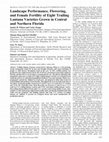
HortScience, 2020
Trailing lantana [Lantana montevidensis (Spreng.) Briq.] is a low-growing, woody ornamental value... more Trailing lantana [Lantana montevidensis (Spreng.) Briq.] is a low-growing, woody ornamental valued for its heat and drought tolerance and repeat blooming of purple or white flowers throughout much of the year. In 2011, trailing lantana was predicted to have high invasion risk by the UF-IFAS’s assessment of non-native plants in Florida, and therefore it was no longer recommended for use. All cultivars fall under this designation unless proven otherwise. Eight trailing lantana varieties were obtained from wholesale growers or naturalized populations found in Texas and Australia. Plants were propagated vegetatively, finished in 4-inch pots, and planted in field trials located in central (Balm) and northern (Citra) Florida. Throughout the 24-week study from June to November, mean plant quality was between 4.4 and 4.7 (on a 1 to 5 scale) for U.S. varieties and 3.9 for the Australian form. Mean flowering was between 4.1 and 4.5 (on a 1 to 5 scale) for U.S. trailing lantana varieties and 3...

Experimental and Applied Acarology, 2020
The parasitic mite Varroa destructor Anderson and Trueman continues to devastate western honey be... more The parasitic mite Varroa destructor Anderson and Trueman continues to devastate western honey bee (Apis mellifera L.) colonies throughout most of the world where they are managed. The development of a method to rear Varroa in vitro would allow for yearround Varroa research, rapidly advancing our progress towards controlling the mite. We created two separate experiments to address this objective. First, we determined which of four in vitro rearing methods yields the greatest number of Varroa offspring. Second, we attempted to improve the rearing rates achieved with that method. The four methods tested included (1) rearing Varroa on honey bee pupae in gelatin capsules, (2) rearing Varroa on in vitro-reared honey bees, (3) group rearing Varroa on honey bee pupae in Petri dishes, and (4) providing Varroa a bee-derived diet. The number of reproducing females and the number of fully mature offspring were significantly higher in the gelatin capsules maintained at 75% RH than in any other method. A 2 × 3 full factorial design was used to test combinations of gelatin capsule size (6 and 7 mm diameter) and relative humidity (65, 75, or 85%) on Varroa rearing success. Varroa reproduction and survival were significantly higher in 7-mm-diameter gelatin capsules maintained at 75% RH than in those maintained in 6-mm capsules and at the other humidities. By identifying factors that influence Varroa reproductive success in vitro, this work provides an important foundation for the development of future rearing protocols.
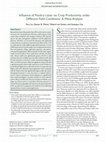
Agronomy Journal, 2018
Research has shown that poultry litter (PL) can be used as a nutrient source for crop production.... more Research has shown that poultry litter (PL) can be used as a nutrient source for crop production. However, yield responses often varied when compared with inorganic fertilizer (IF) depending on soil type, management conditions, and PL application practices. Therefore, we reviewed the literature and conducted a meta-analytic assessment to summarize the effects of PL vs. IF on yield response under different agricultural practices. A total of 866 observations from 90 studies were evaluated to determine how soil properties, tillage, application practices, crop species, and repeated applications influenced yield. Poultry litter significantly increased yield in loam, sandy loam, and silty-clay loam soils, whereas yields were significantly greater with IF in sand and silty-clay soils; no differences were observed between PL and IF with clay loams or silt loams. Under conventional tillage, IF's effect on yield was positive, albeit not significant, whereas PL had a significant positive effect under strip-till or no-till. Poultry litter produced slightly lower yield when surface incorporated, but higher yield with subsurface band application when compared with IF. Poultry litter had significantly higher yield with cotton (Gossypium hirsutum L.), corn (Zea mays L.), soybean [Glycine max (L.) Merr.], and peanut (Arachis hypogaea L.), significantly lower with bermudagrass [Cynodon dactylon (L.) Pers] than IF, and no effects on tall fescue (Festuca arundinacea Schreb.), corn silage, rice (Oryza sativa L.), and wheat (Triticum aestivum L.). Overall, PL was comparable to IF. However, the greatest benefits of PL on yield when compared to IF tended to occur following repeated (three or more) annual applications.
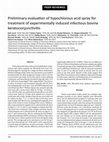
Thirty dairy bull calves with normal ophthalmic examinations and culture-negative for Moraxella b... more Thirty dairy bull calves with normal ophthalmic examinations and culture-negative for Moraxella bovis were randomly assigned to 3 groups for a single eye block, randomized, blinded challenge study. Calves were housed in an accredited isolation facility. In calves assigned to Groups 1 and 2, a 0.6 cm corneal lesion was made on the left central cornea utilizing n-heptanol, and immediately inoculated topically with 1.0 x 107 of M. bovis (strain Epp63-300; origin: NADC). The left eye of calves in Group 3 was inoculated topically with M. bovis, but nothing further. In Group 1,2 mL of 0.009% hypochlorous acid (Vetericyn Plus™ Pinkeye Spray) was sprayed topically onto each calf's cornea twice daily for 10 days. In Group 2, 2 mL of 0.9% saline was administered topically to each calf's cornea twice daily for 10 days. Each animal was scored for ocular pain twice daily. Samples from all eyes were collected for culture on days -7, 0,1,4, and 10. Eyes of all calves were stained daily wit...
Florida Entomologist, 2020

The Canadian veterinary journal = La revue veterinaire canadienne, 2020
The objective of this retrospective study was to compare preoperative and postoperative tracheal ... more The objective of this retrospective study was to compare preoperative and postoperative tracheal measurements in brachycephalic dogs undergoing surgical treatment of brachycephalic airway syndrome (BAS) using 2 radiographic methods (TD:TI and TT:3R). Medical records of 24 brachycephalic dogs with surgically corrected BAS were reviewed. Represented breeds included English bulldogs (n = 9), French bulldogs (n = 9), pugs (n = 5), and a Japanese chin (n = 1). Dogs with BAS that had postoperative thoracic radiographs ≤ 1 week after surgery showed no significant difference in the mean TD:TI ratios (P = 0.06) or mean TT:3R ratios (P = 0.19) when comparing preoperative to postoperative ratios. Dogs that had postoperative thoracic radiographs > 1 week after surgery showed no significant difference in the mean TD:TI ratios (P = 0.06) or mean TT:3R ratios (P = 0.32) when comparing preoperative to postoperative ratios. According to these findings, surgical correction for BAS does not resolve...
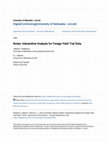
Forage cultivar evaluation is often done in small plots with moltiple harvests throulghout the gr... more Forage cultivar evaluation is often done in small plots with moltiple harvests throulghout the growing season. Data is often summarized by presenting a yearly total yield for each cultivar in addition to the mean for each harvest date. Data summarization oftcn becomes burdensome arid dscult to interpret. Regressing yield against a growth index associated with harvest dates can be utilized to describe forage j)erfomrmance in a concise and easily interpretcd format. Subsets of data from tall fescue (Fesfuca amndinaeea Schreb.) yield trials conducted in Alabama and Kentucky were used to demonstrate the technique. The analysis involves regressing yidd of a cultivar against an index calculated as the mean of all entries at a harvest date minus the grand mean. The resulting re-gression coefficient (b) describes cultivar yield response over several harve 3ts and is indicative 01 performance under variable growth conditioris. ORAGES used ffor grazing are best evaluated by F means of grazing...

Journal of Apicultural Research, 2021
Oxalic acid (OA) is a natural compound that has been used to control the honey bee (Apis mellifer... more Oxalic acid (OA) is a natural compound that has been used to control the honey bee (Apis mellifera) pest Varroa destructor. One method of OA application gaining popularity among beekeepers in the US involves vaporizing OA crystals with heat inside a closed hive. Herein, we tested different doses of OA applied via vaporization to determine the most effective amount of OA needed to reduce V. destructor populations below that of the negative controls. Forty experimental colonies were assigned to one of four treatment groups, with ten colonies composing each group. The four treatments were: (1) 1 g OA, (2) 2 g OA, (3) 4 g OA and (4) no OA (negative control). The OA was applied via vaporization once per week for three weeks. V. destructor infestation rate and colony strength assessments were estimated before, during, and after treatment applications. Colonies in the 4 g OA treatment group had significantly lower infestation rates than did those in the untreated control and 1 g OA treatment groups, but not those in the 2 g OA treatment group. The infestation rate of colonies treated three times with 1 g OA, which is the current legal limit for OA vaporization in the US, was not significantly different from that of colonies in the negative control or 2 g OA treatment groups. Colonies receiving the highest dose of OA were generally healthier than those treated at lower OA doses. Our results may lead to improved efficacy of OA vaporization, thus aiding beekeepers in their efforts to control V. destructor.
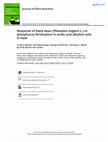
Journal of Plant Nutrition, 2019
Haiti experiences one of the lowest yields of black bean (Phaseolus vulgaris) in the world (660 K... more Haiti experiences one of the lowest yields of black bean (Phaseolus vulgaris) in the world (660 Kg/ha), although is the most consumed among all kind of beans. This is primarily due to poor soil and agronomic management, improper balance of soil nutrients, and limited fertilizer applications, which can lead to malnutrition, ecosystem degradation, and food insecurity, common to developing countries. Phosphorous (P) remains one of the major limitations for black bean production in both lowland and upland areas of Haiti. Included in nucleic acids, P plays a large role in plant reproduction and grain production. When soil does not have enough P available, it impacts plant growth and enhances micronutrient deficiencies, which will affect the physiological maturity. To evaluate black bean growth and yield, a pot study was conducted with two different soils (Kenscoff, acidic and Cabaret, alkaline) in Haiti using a completely randomized block design, replicated four times with four P rates (0, 44, 55, and 66 Kg/ha). Black bean in the alkaline soil achieved its highest yield when 55 Kg/ha was applied, and the acidic soil reached its optimum yield with the application of 44 Kg/ha. High amount of fertilizer is needed to meet the crop requirements, particularly when soil test P is low, especially when P can be potentially fixed by Fe or Al (acidic soil) or by Ca (alkaline soil). This study contributes to the first step in optimizing black bean production through better interpretation and nutrient recommendation of soil tests for Haitian soils.
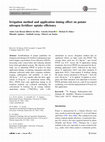
Nutrient Cycling in Agroecosystems, 2018
Establishment of proper guidelines for irrigation and nitrogen (N) fertilizer management may lead... more Establishment of proper guidelines for irrigation and nitrogen (N) fertilizer management may lead to higher crop fertilizer N use efficiency (FNUE), increasing water conservation and reducing nutrient losses from agricultural systems. The objective of this study was to determine FNUE of potato for three application timings: at planting, emergence and tuber initiation cultivated under three irrigation methods: seepage, subirrigation and sprinkler. A total of 168 kg ha-1 of N was equally split into three applications of 56 kg ha-1 as ammonium nitrate (NH 4-NO 3). FNUE from each application timing in all irrigation methods was evaluated substituting the conventional N fertilizer by an isotope labeledammonium nitrate (15 NH 4 15 NO 3) with 1.18% enrichment in excess. Irrigation method had no significant effects on tuber yield and FNUE. The average tuber yield was 32.1 Mg ha-1 and overall FNUE was 41%. Across the N application timing treatments, the lowest FNUE was measured for the atplanting application (18%), followed by the emergence N application (44%) and tuber initiation N application (62%). Unaccounted N fertilizer during the potato season amounted to 98 kg ha-1 from the total 168 kg ha-1 of N applied. N applied at emergence and tuber initiation were important to increase FNUE and tuber yield, however, some N was required at planting, even with the high potential of N losses for that application. Keywords 15 N Á Seepage Á Subirrigation with drainage tile Á Sprinkler Á Biomass accumulation Á Tuber yield Á Soil N Á Atlantic potato

Herbicides, Agronomic Crops and Weed Biology, 2015
White lupin is of increasing interest in the southeastern United States (US) as a winter legume c... more White lupin is of increasing interest in the southeastern United States (US) as a winter legume cover crop or as midwinter forage for ruminants. White lupins are poor weed competitors during early establishment, making effective weed control necessary; however, only three herbicides are currently registered for use in lupin. An experiment was conducted at two Alabama sites in 2007 and 2008 to evaluate herbicide efficacy provided by ten preemergence (PRE) and nine postemergence (POST) herbicides as well as lupin injury and yield. Overall, PRE applied herbicides, particularly imazethapyr, linuron, and flumioxazin, caused less crop injury than POST herbicides while providing ≥ 86% control of annual bluegrass, corn spurry, heartwing sorrel, henbit, and lesser swinecress six weeks after application. Grass-active herbicides, fluazifop and sethoxydim, provided greater than 95% of annual bluegrass control without causing unrecoverable lupin damage. Imazethapyr applied POST controlled shepherd's purse (96% to 98%), cutleaf evening-primrose (81% to 96%), and wild radish (71% to 99%) without lupin injury. POSTdirected spray applications of glyphosate and flumioxazin provided good weed control of corn spurry (80% to 98%) and winter vetch (71% to 95%) but caused significant crop injury due to drift. In general, grain yields were only reduced with the use of chlorimuron, diclosulam, glyphosate, and thifensulfuron. This research suggests there are several herbicides not currently registered that could be beneficial for use in US lupin production.
Journal of Plant Registrations, 2015
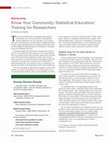
CSA News, 2013
News & Perspectives T he Statistical Education/Training for Researchers Community was one of the ... more News & Perspectives T he Statistical Education/Training for Researchers Community was one of the earliest Communities formed under the new ASA structure. The Community, part of the Biometry and Statistical Computing Section, has the single-minded purpose to enhance practical statistical knowledge by offering hands-on training for colleagues across our affi liated Societies. Conducting fi eld and laboratory experiments is becoming ever more elaborate and expensive. Yet, a quick glance into our journals shows that statistical analysis has not kept pace with technical development in many areas of agronomic research. It is the goal of this Community to provide researchers with hands-on training to do a better job of analyzing their data. The primary venue is workshops conducted on Sunday at the beginning of the Annual Meetings. The fi rst workshop, predating the formation of this Community, was held in Long Beach, CA in 2010 and focused on mixed-models analysis. The second workshop was held Society Election Results The ASA, CSSA, and SSSA elections were completed in March, with the following selected as the 2014 Presidents-Elect:

Scientia Horticulturae, 2021
Abstract Plant use efficiency of applied N is estimated to be around 50 % for most crops. In coas... more Abstract Plant use efficiency of applied N is estimated to be around 50 % for most crops. In coastal plain sandy soils particularly, leaching along with volatilization in warmer climates may be a predominant pathway for N loss to the environment. A replicated field study to determine both crop N requirement and recovery efficiency of N (REN) in tomatoes (var. BHN 602) grown on sandy soils under a plastic-mulched bed system was conducted in north Florida. Isotope labeled-ammonium nitrate (15NH415NO3) was applied in spring at four different N rates (0, 168, 224, 280 kg N ha−1). A subsequent study in the fall was conducted in order to determine the recovery of residual N fertilizer in tomatoes. In spring, no appreciable response to applied fertilizer N rate above 168 kg N ha−1 (lowest rate) were observed, indicating recommended N rates may be more than what is required. On average, approximately, 62 % of N accumulation in the plant came from fertilizer, whereas 38 % came from soil N. In the fall, recovery of residual 15N fertilizer at harvest ranged from 1.9 to 5.4 kg N ha−1. At the end of both studies, a 15N balance was calculated to estimate total crop and soil recovery of N fertilizer, where approximately 15.4 % of applied 15N fertilizer was recovered. Unrecovered N in this study shows that optimizing N fertilizer management in warmer climates is critical in order to avoid unnecessary excess application of fertilizer and minimize loss of N to the environment.
age, 2019
• Perennial forage-crop rotation did not increase soil greenhouse gases emissions compared to ann... more • Perennial forage-crop rotation did not increase soil greenhouse gases emissions compared to annual peanut-cotton rotation. • Carbon storage was greater for perennial forage-crop rotation compared to continuous peanut-cotton rotation. • Grazing resulted in increased uptake of soil CH 4 in some instances.
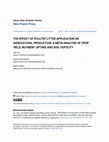
Conference on Applied Statistics in Agriculture, 2016
Meta-analysis is a statistical technique used to analyze large datasets containing results from n... more Meta-analysis is a statistical technique used to analyze large datasets containing results from numerous individual studies. It appears to be a promising approach in agricultural sciences. This study aimed to conduct a meta-analytic assessment to elucidate the influence of poultry litter (PL) application on crop yield, plant nutrient uptake, and soil fertility as compared to inorganic fertilizer (IF). A meta-analysis based on 116 studies (111 refereed articles and five unpublished data sets) with 2293 observations compared agronomic responses to PL and IF application. The natural log of the response ratio was used as effect size (ES) to express differences in the effects of PL and IF. The variances of estimated effects were estimated using within-study and betweenstudy variation and were used to calculate a weighting factor. A random-effects model was used to test if the ES was significantly different from zero (α= 0.05).

Soil Science Society of America Journal, 2014
ABSTRACT A frequently used cropping system in the southeastern Coastal Plain is an annual rotatio... more ABSTRACT A frequently used cropping system in the southeastern Coastal Plain is an annual rotation of cotton (Gossypium hirsutum L.) and peanut (Arachis hypogaea L.) under conventional tillage (CT). The traditional peanut-cotton rotation (TR) often results in erosion and loss of soil organic carbon (SOC). Incorporation of bahiagrass (Paspalum notatum Fluegge) into the peanut-cotton rotation for 2 yr (also called a sod-based rotation or SBR) has been suggested for improving SOC, particularly in conjunction with conservation tillage practices. To determine the effect of the SBR on carbon sequestration, SOC and its isotopic composition were evaluated on established (>10 yr) crop rotation systems. Cropping systems evaluated included (i) TR under CT, (ii) TR under strip tillage (ST), (iii) SBR under CT, (iv) SBR under ST, and (v) SBR under ST with cattle grazing. Total SOC, bahiagrass-derived SOC, and potential C mineralization increased in the top 10 cm of soil, indicating the potential for ST to improve soil fertility in SBR systems. Grazing bahiagrass decreased SOC in the 5 to 10 cm depth, but this effect was not observed for the subsequent peanut crop and did not appear to have a long-term negative effect on SOC storage. The SBR did not show consistent improvements in total SOC compared with the TR. A 3-yr comparison of SOC concentration revealed C increases in SBR and TR systems, indicating that other conservation practices (e. g., winter cover cropping) are the primary contributors to SOC storage for Coastal Plain soils evaluated in this study. Isotopic analysis of mineralized CO2 indicated bahiagrass-derived SOC may be preferred over C-3 crop-derived SOC for degradation.
Agronomy Journal, 2014
All rights reserved. No part of this periodical may be reproduced or transmitted in any form or b... more All rights reserved. No part of this periodical may be reproduced or transmitted in any form or by any means, electronic or mechanical, including photocopying, recording, or any information storage and retrieval system, without permission in writing from the publisher.
Agronomy Journal, 2004
... Harbans L. Bhardwaj * a ,; Anwar A. Hamama a and; Edzard van Santen b. a Agric. Res. ... 2002... more ... Harbans L. Bhardwaj * a ,; Anwar A. Hamama a and; Edzard van Santen b. a Agric. Res. ... 2002a. Crop production 2001 summary [Online]. Available at http://usda.mannlib.cornell.edu/reports/nassr/ field/pcp-bban/cropan02.pdf (verified 24 Nov. 2003). Cr Pr 21 (02). ...







Uploads
Papers by Edzard van Santen